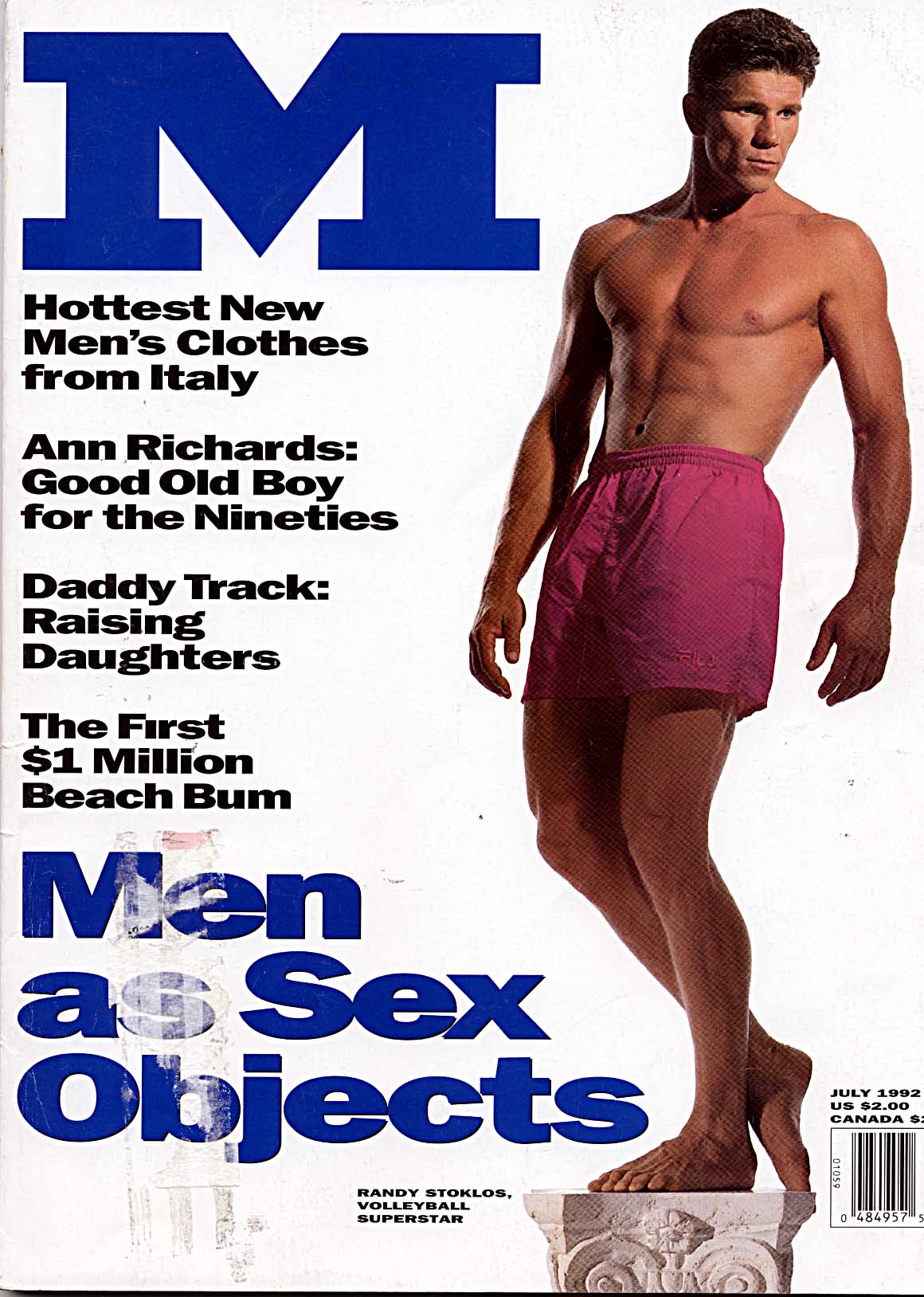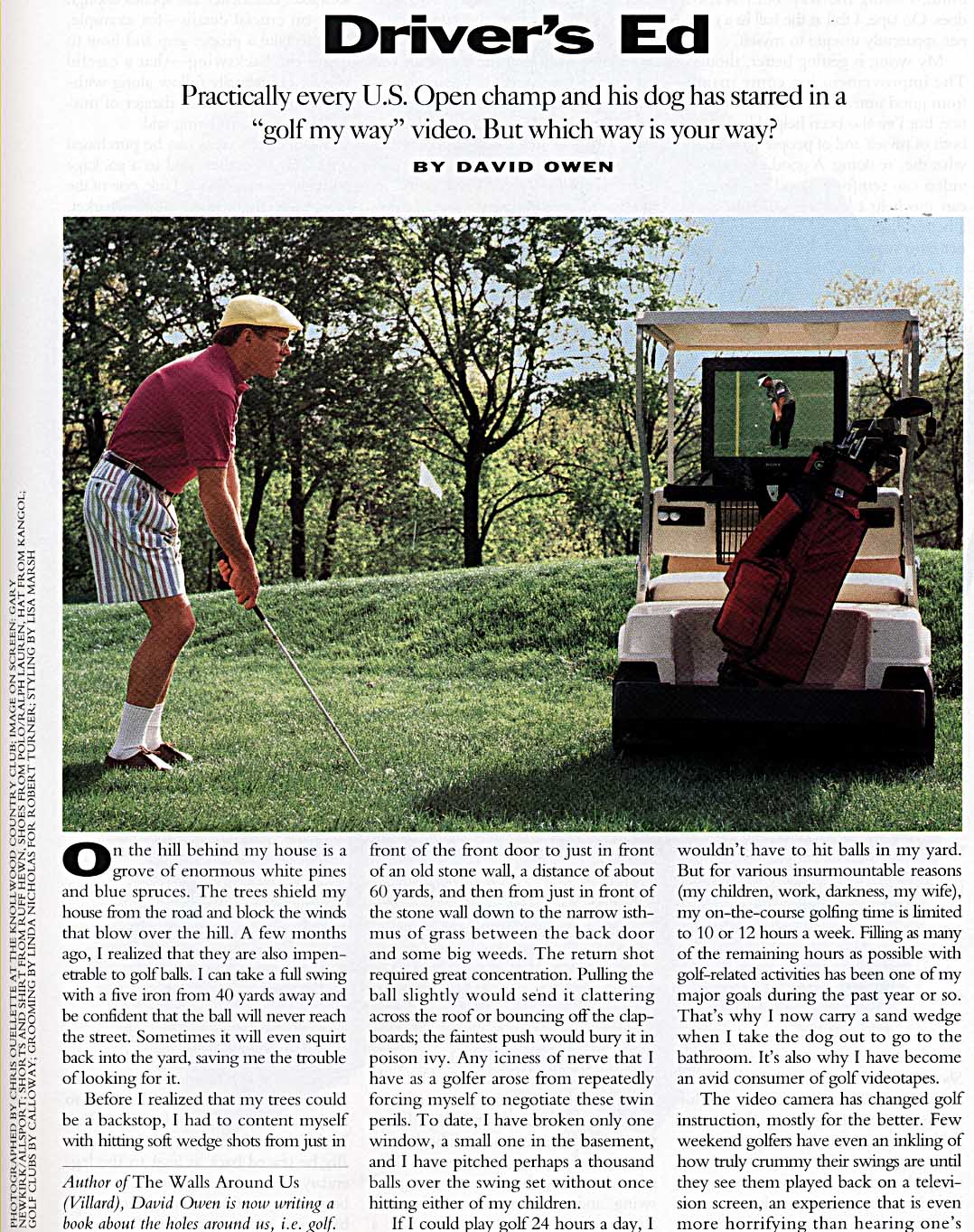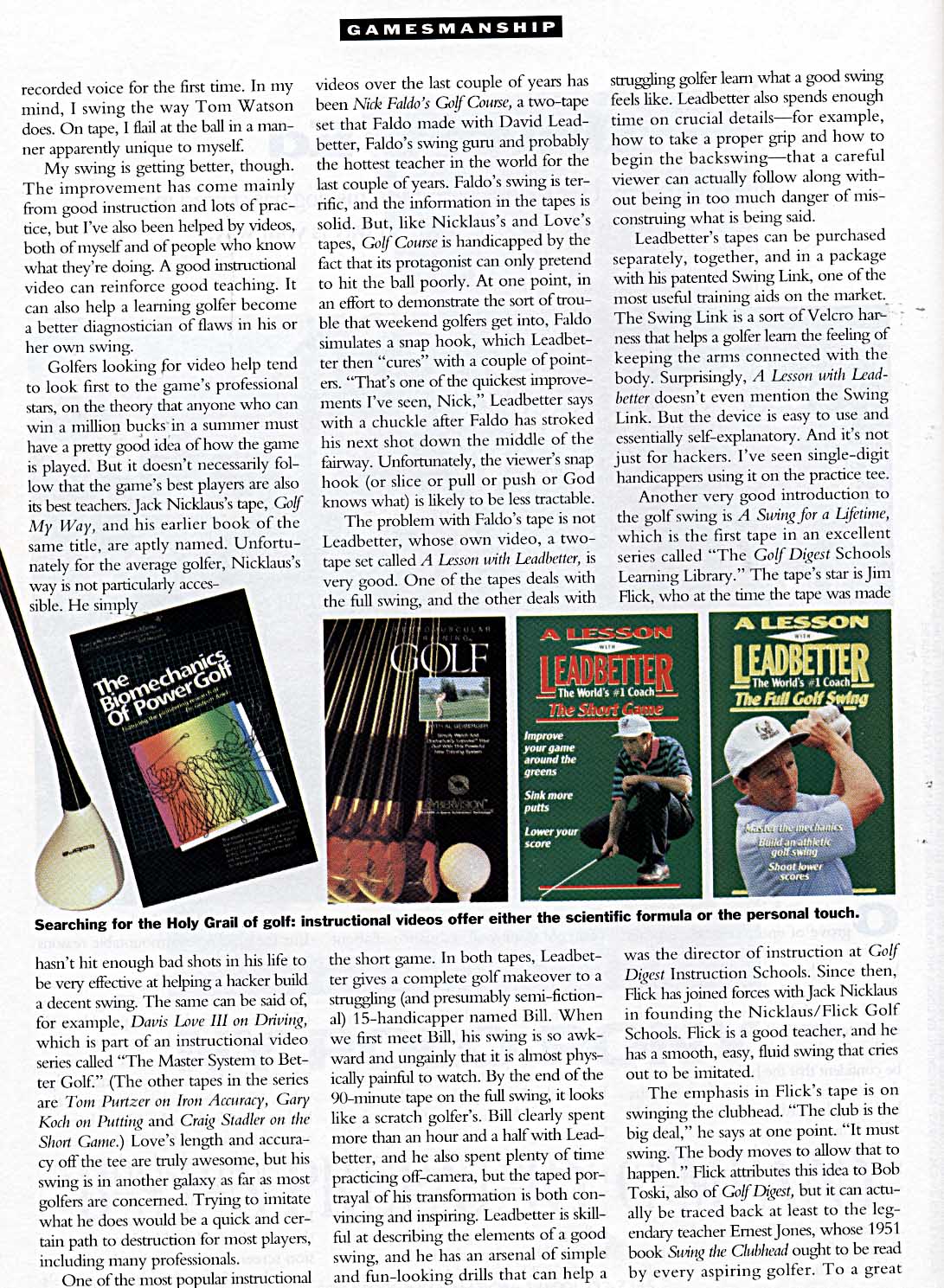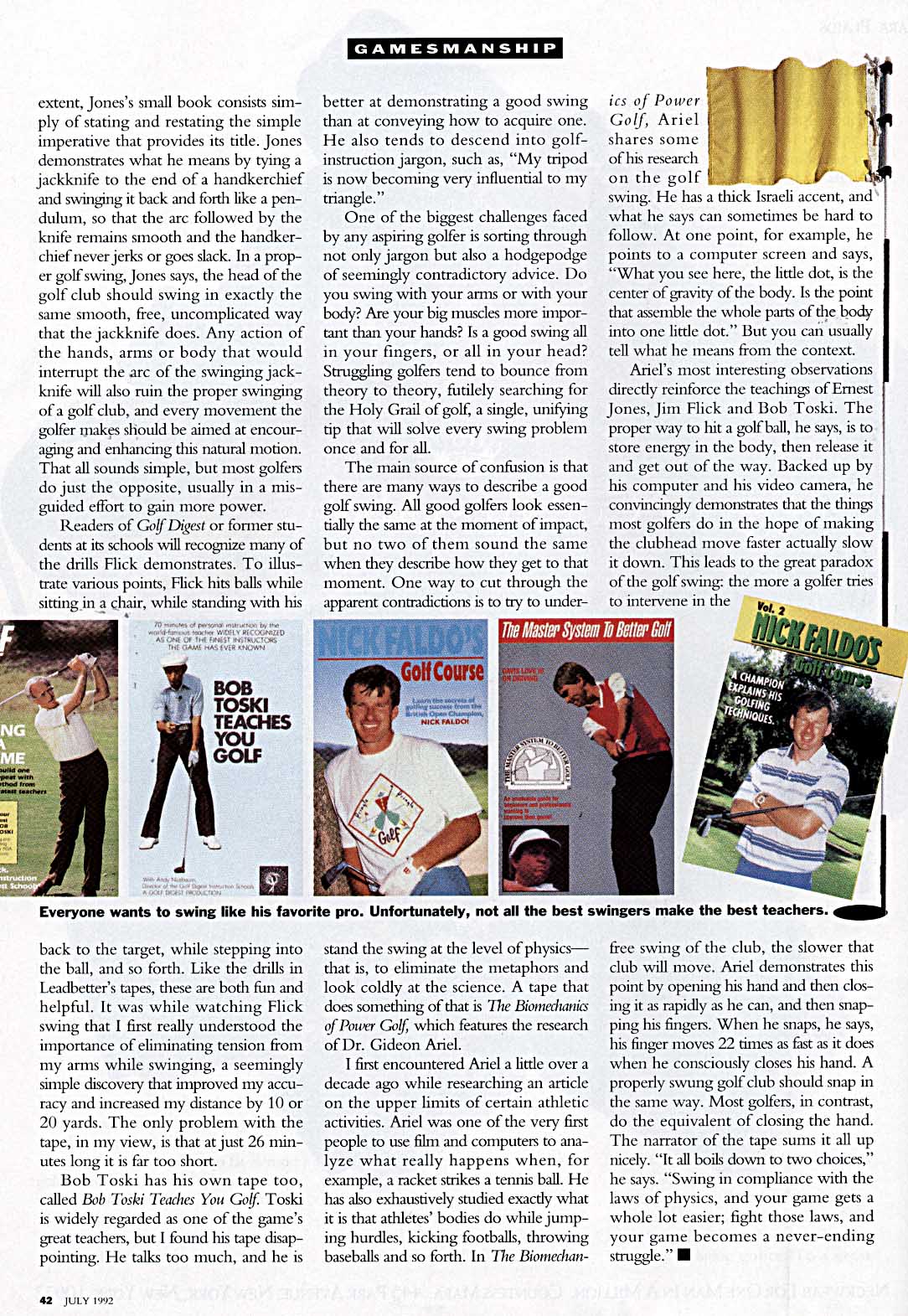Driver's Ed
Practically every U.S. Open champ and his dog has starred in a " golf my way" video
By David Owen in M on Wednesday, July 1, 1992
Driver's Ed
In this article, David Owen explores the world of golf instructional videos. He discusses his personal experiences with golf and how he has used these videos to improve his swing. Owen reviews several popular instructional videos, including those by Jack Nicklaus, Davis Love III, and Nick Faldo. He also discusses the work of Dr. Gideon Ariel, who uses film and computers to analyze the physics of a golf swing. Owen concludes that while these videos can be helpful, they are not a substitute for practice and good instruction.
Tip: use the left and right arrow keys
Driver's Ed
Practically every U.S. Open champ and his dog has starred in a
" golf my way" video. But which way is your way?
BY DAVID OWEN
On the hill behind my house is a grove of enormous white pines and blue spruces. The trees shield my house from the road and block the winds that blow over the hill. A few months ago, I realized that they are also impenetrable to golf balls. I call take a fill swing with a five iron from ii 40 yards away and be confident that the hall ss.ill never reach the street. Sonietiunes it will even squirt back into the yard, saving me the trouble of looking for it.
Before I realized that nmv trees could be a backstop, I had to content myself with hitting soft wedge shots from just in
Author o[ The Walls Around Us
(Villard), David Uuveu is non' writing a (rook about the holes around us, i.e. _t'oll.
front of the front door to just in front of an old stone wall, a distance of about 60 yards, and then from just in front of the stone wall down to the narrow isthinus of grass between the hack door and sonic big weeds. The return shot required great concentration. Pulling the ball slightly would send it clattering across the roof or bouncing of the clapboards; the faintest push would bury it in poison ivy. Any iciness of nerve that I have as a golfer arose from repeatedly forcing myself to negotiate these twin perils. To date, I have broken only one window, a small one in the basement, and I have pitched perhaps a thousand balls over the swing set without once hitting either of my children.
If I could play golf 24 hours a day, 1
- ZA~
wouldn't have to hit balls in my yard. But for various insumnountable reasons (my children, work, darkness, my wife), my on-the-course golfing time is limited to 10 or 12 hours a week. Filling as nrnny of the remaining hours as possible with golf-related activities has been one of my major goals during the past year or so. That's why I now carry a sand wedge when I take the dog out to go to the bathroom. It's also why I have become an avid consumer of golf videotapes.
The video camera has changed golf instruction, mostly for the better. Few weekend golfers have even an inkling of how truly crummy their swings are until they see them played back on a television screen, an experience that is even more horrifying than hearing one's
GAMESMANSHIP
recorded voice for the first time. In my mind, I swing the way Tom Watson dots. On tape, I flail at cite ball in a manner apparently unique to myself.
My swing is getting better, though. The improvement has come mainly from good instruction and lots of practice, but I've also been helped by videos, both of myself and of people -who know what they're doing. A good instructional video call reinforce good teaching. It cat) also help a learning golfer become a better diagnostician of flaws in his or her own swing.
Golfers looking for video help tend to look first to the game's professional stars, on the theory that anyone who can win a million bucks in a summer must have a pretty good idea of how the gone is played. But it doesn't necessarily follow that the ga"'e's best players arc also its best teachers. Jack Nicklaus's tape, Colt My IVay, and his earlier book of the same title, are aptly named. Unfortunately for the average goiter. Nic klaus's way is not particularly u rcti sihle. He simply
videos over the last couple of years has been .'Milt Faldo's (Half Course, a two-tape set that Faldo made with David Leadbetter, Faldo's swing guru and probably the hottest teacher in the world for the Last couple of years. Faldo's swing is terrific, and the inh'r"'ation in the tapes is solid. But, like Nicklaus's and Love's tapes, (~e1f Course is handicapped by the tart that its protagonist can only pretend to hit the ball poorly. At one point, in an effort to demonstrate the sort of trouble that weekend golfers get into, Faldo simulates a snap hook, which Leadbetter then "cures" with a couple of pointers. "That's one of the quickest improvements I've seen, Nick," Leadbetter says with a chuckle after Faldo has stroked his next shot down the middle of the fiairway. Unfortunately, the viewer's snap hook (or slice or pull or push or God knows what) is likely to be less tractable.
The problem with Faldo's tape is not Leadbetter, whose own video, a twotape set called A lesson with Leadbetter, is very good. One of the tapes deals with the full swing, and the other deals with
stnagghng golfer leant what a good swing feels like. Leadbetter also spends enough time on crucial details-for example, how to take a proper grip and how to begin the backswi"g-that a careful viewer can actually follow along without being in too much danger of misconstruing what is being said.
Leadbetter s tapes can be purchased separately, together, and in a package with his patented Swing Link, one of the most useful training aids on the market. The Swing Link is a sort of Velcro bar, ness that helps a golfer learn the feeling of keeping the arms connected with the body. Surprisingly, . 1 Lesson u'itlt Leadbetter doesn't even mention the Swing Link. But the device is easy to use and essentially self-explanatory. And it's not just for hackers. I've seen single-digit handicappers using it on the practice tee.
Another very good introduction to the golf swing is A SurirWJiar a Lif�tirnc, which is the first tape in an excellent series called "The Golf I)it'est Schools Leamimg Library." The tape's star is Jim Flick. who at the tinge the tape was made
Searching for the Holy Grail of golf: instructional videos offer either the scientific formula or the personal touch.
hasn't hit enough had shots in his lite to be very effective at helping a hacker build a decent swing. The same can be said of, for example, Davis Love III oil I hivini, which is pan of an instructional video series called "'the Master System to Better (.oil- " (Tile other tapes in the series are 7'orrr Purher ott Iron Aicuraq% Gary Kodr on Prettirrt, and (:rain Stadler ort the Short Gaure.) Love's length and accuracy oil the tee are truly awesome, but his swing is in another galaxy as far as most golfers are concerned. Trying to imitate what he does would be a quick and certain path to destruction for most players, including nanny professionals.
One of the most popular instructional
the short game. In both tapes, Leadbetter gives a complete golf makeover to a stns ling (and presumably semi-fictional) 15-handicapper named Bill. When we first meet Bill, his swing is so awkward and ungainly that it is almost physically painful to watch. By the end of the (,X)-minute tape on the hill swing, it looks like a scratch goiter's. 13111 clearly spent more than an hour and a half with Leadbetter, and he also spent plenty of time practicing off-camera, but the taped portrayal of his transforniation is both convincing and inspiring. Leadbetter is skillful at describing the elements of a good swing, and lie has an arsenal of simple and fiun-looking drills that can help a
was the director of instruction at Golf 1)it'est Instruction Schools. Since then, Flick has joined forces with Jack Nicklaus in founding the Nicklaus/Flick Golf Schools. Flick is a good teacher, and he has a smooth, easy, fluid swing that cries out to be imitated.
The emphasis in Flick's tape is on swinging the clubhead. "The club is the big deal," lie says at one point. "It "'list swing. The body moves to allow that to happen." Flick attributes this idea to Bob Toski, also of Golf l)it'cst, but it can actually be traced back at least to the legendan' teacher Frnest Jones, whose 1951 book Suarrte the Cl,,Glread ought to Lie read by every aspiring golfer. To a great
GAMESMANSHIP
r
extent, Jones's small book consists simply of stating and restating the simple imperative that provides its title. Jones demonstrates what he means by tying a jackknife to the end of a handkerchief and swinging it hack and forth like a pendulum, so that the arc followed by the knife remains smooth and the handkerchief never jerks or goes slack. In a proper golf swing, Jones says, the head of the golf club should swing in exactly the same smooth, free, uncomplicated way that the jackknife does. Any action of the hands, arms or body that would interrupt the arc of the swinging jackknife will also ruin the proper swinging of a golf club, and every movement the golfer makes should be aimed at encouraging and enhancing this natural motion. That all sounds simple, but most golfers do just the opposite, usually in a misguided effort to gain more power.
Readers of Golf Digest or former students at its schools will recognize many of the drills Flick demonstrates. To illustrate various points, Flick hits balls while sitting i n a chair, while standing with his
better at demonstrating a good swing than at conveying how to acquire one. He also tends to descend into golfinstruction jargon, such as, "My tripod is now becoming very influential to my triangle."
One of the biggest challenges faced by any aspiring golfer is sorting through not only jargon but also a hodgepodge of seemingly contradictory advice. 1)o you swing with your arms or with your body? Are your big muscles more important than your hands? Is a good swing all in your fingers, or all in your head? Struggling golfers tend to bounce from theory to theory, futilely searching for the Holy Grail of golf a single, unifying tip that will solve every swing problem once and for all.
The main source of confusion is that there are many ways to describe a good golf swing. All good golfers look essentially the same at the moment of impact, but no two of them sound the same when they describe how they get to that moment. One way to cut through the apparent contradictions is to try to u nder
ics of Power S
Golf, Ariel shares some J
of his research
on the golf !; .
swing. He has a thick Israeli accent, and what he says can sometimes he hard to follow. At one point, for example, he points to a computer screen and says, "What you see here, the little dot, is the center of gravity of the body. Is the point that assemble the whole parts of the body into one little dot." But you can usually tell what he means from the context.
Ariel's most interesting observations directly reinforce the teachings of Er nest Jones, Jim Flick and Bob Toski. The proper way to hit a golf ball, he says, is to store energy in the body, then release it and get out of the way. Backed up by his computer and his video camera, he con vncingly demonstrates that the firings most golfers do in the hope of making the clubhead move faster actually slow it downn. This leads to the great paradox of the golf swing,~ the more a golfer tries
to intervene in the Ira =
I
BOB TOSKI TEACHES YOU GOLF
J
Everyone wants to swing like his favorite pro. Unfortunately, not all the best swingers make the best teachers.
back to the target, while stepping into the ball, and so forth. Like the drills in Leadbetter's tapes, these are both fine and helpful. It was while watching Flick swing that I first really understood the importance of eliminating tension from my antis while swinging, a seemingly simple discovery that improved my accuracy and increased miry distance by 10 or 20 yards. The only problem with the tape, in my view, is that at just 26 minutes long it is far too short.
Bob Toski has his own tape too,
called a)/) 7'o ski Teaches You Golf Toski
is widely regarded as one of the game's great teachers, but I found his tape disappointing. 1-Ic talks too much, and he is
stand the swing at the level of physicsthat is, to eliminate the metaphors and look coldly at the science. A tape that does something of that is 71w Biornechauics of Pow r Golf which features die research of Dr. Gideon Ariel.
I first encountered Ariel a little over a decade ago while researching all article on the upper limits of certain athletic activities. Ariel was one of the very first people to use film and computers to analyze what really happens when, for example, a racket strikes a tennis ball. He has also exhaustively studied exactly what it is that athletes' bodies do while jumping hurdles, kicking footballs, throwing baseballs mid so forth. In Vie Blomechan
free swing of the club, the slower that club will move. Ariel demonstrates this point by opening his hand and then closing it as rapidly as lie can, and then snapping his fingers. When lm snaps, he says, his finger moves 22 times as fast as it does when he consciously closes his hand. A properly swung golf club should snap in the same sway. Most golfers, in contrast, do the equivalent of closing the hand. The narrator of the tape sums it all up nicely. "It all boils down to two choices," he says. "Swing in compliance with the laws of physics, and your game gets a whole lot easier; fight those laws, and your game beconies a never-ending smuggle."
42 JULY 1992




